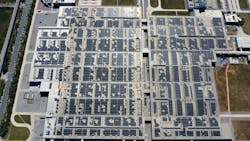Goodyear Tire & Rubber Company Installs 29,700 Solar Panels at Manufacturing Plant in China
The Goodyear Tire & Rubber Company has installed 29,700 solar panels at its Pulandian manufacturing plant in Dalian, China.
The panels will not only power the plant but also the offices and warehouse buildings. The panels are estimated to reduce carbon emissions from purchased electricity by 17,000 metric tons per year over 25 years.
Goodyear aims to transition its manufacturing operations and processes to renewable energy by 2040, with a mid-term goal of 100% renewable electricity in its manufacturing operations by 2030.
Goodyear's investments in solar power generating technology in the Asia Pacific region created a generation capacity of approximately 28 MW of electricity, while it operates onsite solar generation systems at 10 facilities globally, with a total capacity of 30 MW.
"We are increasing our use of renewable energy in our manufacturing facilities with solar installations at our plants in China, India, Indonesia, Malaysia, and Thailand," said Nathaniel Madarang, President at Goodyear Asia Pacific. "We expect to continue to add additional onsite solar capacity in our region, helping us to reach our corporate-wide 2030 and 2040 goals."
About the Author
EnergyTech Staff
Rod Walton is senior editor for EnergyTech.com. He has spent 17 years covering the energy industry as a newspaper and trade journalist.
Walton formerly was energy writer and business editor at the Tulsa World. Later, he spent six years covering the electricity power sector for Pennwell and Clarion Events. He joined Endeavor and EnergyTech in November 2021.
He can be reached at [email protected].
EnergyTech is focused on the mission critical and large-scale energy users and their sustainability and resiliency goals. These include the commercial and industrial sectors, as well as the military, universities, data centers and microgrids.
Many large-scale energy users such as Fortune 500 companies, and mission-critical users such as military bases, universities, healthcare facilities, public safety and data centers, shifting their energy priorities to reach net-zero carbon goals within the coming decades. These include plans for renewable energy power purchase agreements, but also on-site resiliency projects such as microgrids, combined heat and power, rooftop solar, energy storage, digitalization and building efficiency upgrades.
